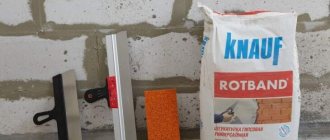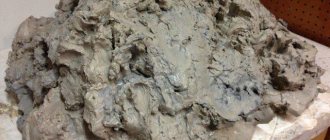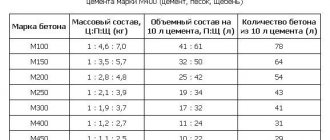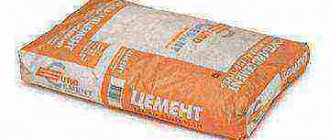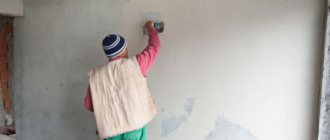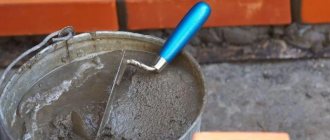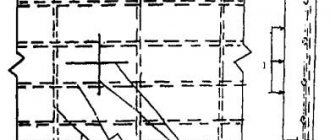Why should you buy clay plaster?
Clay for plastering walls has been actively used in our country for many years. However, at some point this trend stopped. Why? With the advent of new compositions for interior design, such plaster has faded a little into the background. Today, many people remember the undoubtedly high performance qualities for which clay is famous. And for this reason it is in demand again.
Country cottages with this design look very attractive, and the atmosphere in them is characterized by increased comfort. Living in such a house is also good because it creates a healthy microclimate.
Options for preparing plaster
There are several standard solutions that are used for plastering:
- Standard clay-sand;
- Cement-clay-sand;
- Lime-gypsum-clay;
- Gypsum-lime-sand.
Clay-sand
Mortar for plastering a clay oven can be distinguished as one of the most popular due to its simplicity and low cost. The required ingredients are as follows:
- 1 part clay;
- 2 parts sand;
- 0.1 part asbestos;
- pure water.
The proportions of sand and clay for plastering the stove are approximate and can be changed during the preparation process.
Cement-clay-sand
To increase strength and hardness, a portion of cement is added to the solution with clay and sand.
- 1 part cement;
- 1 part clay;
- 2 parts river sand;
- 0.1 part asbestos and fiberglass;
- pure water.
But there is one drawback: the solution must be worked quickly, otherwise it will dry out and become unusable. Cement should be chosen of good quality so that it is not damp and crumbles well.
Lime-clay sand
Slaked lime is added to the standard batch to make work easier. The solution becomes more plate-like and has an attractive appearance.
- 1 part slaked lime;
- 2 parts sand;
- 0.1 part asbestos;
- pure water.
Gypsum-lime
The solution needs to be mixed a little, as much as you can use in a small area. Better to cook again.
- 2 parts slaked lime;
- 1 part construction gypsum;
- 1 part sand;
- 2 parts asbestos fiber;
- pure water.
Gypsum tends to harden quickly, so the finished solution must be used within 30 minutes.
To avoid cracks, heat the oven slightly before applying the mixture. This applies to all types of solution.
What is clay-based plaster?
Plastering a wooden house with clay allows you to increase its operational parameters, preserve the walls from wear and tear and give it external aesthetics.
This is a practical and inexpensive finishing option that can be used for walls both on the outside and on the inside. Moreover, the work of applying the mass to the surface of the walls can be done with your own hands, and the material itself can be dug up on your own site.
Advantages of plaster on clay
The interest that professional builders show today in this material is not accidental. After all, it corresponds to modern construction trends: high requirements for environmental friendliness, affordable cost, external aesthetics.
And at the same time, clay also has a rather impressive number of advantages, including:
- hypoallergenic properties;
- can be used for application to any building material;
- performs the function of a kind of filter for excess moisture, which contributes to micro-regulation of the level of air humidity in the room and preserves the integrity of the walls in the case of exterior finishing;
- affordable price;
- the use of clay is not accompanied by waste;
- can be reused;
- plaster with clay contains only natural ingredients;
- It is easy to prepare such a solution and apply it to the wall surface; you do not need to have extensive experience in the construction industry;
- high protective properties;
- excellent elasticity, which prevents rapid destruction of the surface;
- makes it possible to decorate the surface with a decorative pattern, which refreshes the design and gives high aesthetics to the walls of the house.
Plastering a bathhouse with clay. Clay plaster
Clay plaster is unique among all other types of plaster for interior and exterior walls. The growing interest in clay plasters has recently been associated with the trend of choosing natural, environmentally friendly materials for finishing. Clay is also used for plastering wet rooms (except for showers and walls that are directly affected by water and moisture), but clay plasters are most widely used for masonry and finishing of fireplaces and stoves. Decorative clay plasters with fillers made of straw, sawdust, and plastic fiber occupy a special place in the decoration of eco-interiors. One of the main advantages of clay as a material for plaster is the absolute naturalness and environmental friendliness of the composition. Red and white clay are more common. Natural clay is a sedimentary rock that does not contain mineral components harmful to human health; in addition, clay plasters are able to adsorb harmful components from the air of the home and bind them, which makes clay walls the best finishing option for people prone to allergies. This beneficial effect for the indoor microclimate is complemented by the ability of clay walls to regulate humidity in the house: a layer of clay easily absorbs excess moisture and just as easily releases it back into the indoor air when the humidity level decreases. A few more benefits of clay finishes:
- Ability to conduct heat;
- Hygroscopicity and the ability to accumulate and release moisture;
- The plastic properties of clays make it possible to plaster surfaces operating under conditions of strong heating and sudden cooling: stoves and fireplaces, chimneys;
- Cost-effective, low prices for materials. Possibility of independently procuring clays of excellent quality. Preparing clay is a fairly long but simple process;
- The hardness of clay is less than that of cement plaster, but is sufficient to protect enclosing structures from both mechanical and thermal influences. Clay is impractical only for exterior plinths, but with reinforcing fiber in combination with lime and other binders it is also used for exterior plasters;
- Clays can be used more than once.
Disadvantages of clay plaster
However, with all the advantages of clay, plastering walls with clay with your own hands also has its disadvantages. And they must be taken into account when selecting clay. Let's list the most important of them:
- Covering walls with clay plaster takes quite a long time. Also note that it takes quite a long time to dry;
- The facade of a building plastered with such a solution may crack after some time. This happens either if the technology for using the plaster mass is violated, or with prolonged exposure to direct sunlight or excessive air humidity.
What types of clay solutions exist today?
Do-it-yourself clay plaster is a great way to finish the wall surfaces of a country cottage for little money. However, you should not think that the composition of such material is uniform and unchanged.
Clay plaster: the composition of the solution may differ due to the presence of some additives. And this directly affects the performance parameters of the material.
The main components of a solution of this type are clay, sand and water. And you can also add sawdust, for example, alder or pine, pine needles, felt, wool and the like.
Let us note that plaster with sawdust is in great demand today due to its excellent performance qualities. In addition, the composition with the addition of dung is characterized by good quality, high elasticity, plasticity and thermal conductivity.
How to prepare a clay solution
Let's consider what materials and tools will be needed to prepare the plaster. One of the main positive properties of clay is that it has good adhesion to other materials. The following list of tools will be needed:
- container for mixing the solution;
- shovel;
- screwdriver;
- drill with mixer attachment;
- spatulas;
- sieve or mesh for sifting components;
- perforator (for attaching the mesh).
To prepare and apply the solution, you will need materials such as clay, a metal mesh as a reinforcing element, additional sawdust and dowels for attaching the mesh to the wall. When all the tools and components for the solution are ready, you can start mixing. First of all, the clay must be soaked in water for a day. Next, the resulting solution is thoroughly mixed and excess water is removed. The components used, such as sand, sawdust, are sifted through a sieve to remove various debris. Then the sifted substances are added to the soaked clay, mixing the resulting composition well. The consistency of the finished solution should be similar to a sticky and thick mixture. As for the ratio of clay, sand and sawdust, the proportions should be 1:2:1. After completing the described procedures, the solution is considered ready for application. If the mixture is too sticky, you need to add a little sand.
The correct technique for selecting a clay solution
The choice of plaster formulation requires taking into account certain factors, namely the thermal insulation criterion and the location of application of the solution. So clay with fiber is the most durable and warm composition, which is perfect for rough finishing of building facades. If you add sand to the composition, its plastic and thermal conductivity properties will decrease. However, this option will be more durable.
In the case of a wooden cottage with good thermal insulation, which natural wood is famous for, you can use clay-sand mortar with fiber for finishing. How is clay and sawdust plaster used? The video below will demonstrate the technique of plastering wall surfaces with this material.
What tools are needed to work with clay plaster?
To work with clay plaster without the help of builders, but on your own, you will need to prepare tools such as:
- mixing bowl. Its volume is selected taking into account the working surface area;
- shovel;
- bucket;
- spatulas of different sizes;
- a concrete mixer will only be needed if the volume of plastering work is really large;
- metal brush;
- a metal strainer for sifting the remaining components of the future solution;
- reinforcing mesh to give the building facade greater strength, practicality and durability;
- hardware for fixing the sheathing to the wall surface;
- hammer;
- screwdriver
How to prepare clay mortar correctly and without errors?
Before you begin, please pay attention to the following rules. If the clay is taken from different soils, then it will differ in its parameters. Therefore, it is better to try to choose material from one area. Additives (sand or sawdust) must be carefully sifted, because the quality of these components determines the properties of the future finish.
There are no exact proportions in this case. You need to select them yourself, so do not rush to mix the entire volume of the solution at once. It’s better to prepare small portions of the mass in different versions and, having studied the properties of each, choose one option. Mixing should be done in the following sequence. Determine the actual quantity of each component.
Next, you need to soak the clay for 24 hours. After it swells, it will need to be stirred. Now it's time to sift the sand through a strainer and add sawdust to it if you decide to use that too. After mixing all the ingredients, you can prepare a container of water. Next, pour water into the mixture in a small stream. And they do it slowly, mixing the composition very thoroughly. When the desired consistency is achieved, the solution can be applied to the wall surface.
Remember that preparing the solution is a rather labor-intensive matter. For this reason, for large volumes of work, it is better to use a professional concrete mixer.
How to work with clay plaster: prepare and apply the mixture with your own hands
In modern construction, clay plaster has given way to professional finishing materials. But as before, it remains in demand among people living on their land. In this article we will tell you in what proportions a clay solution is prepared, and how to plaster the walls and ceiling with this affordable and environmentally friendly material.
Where is clay plaster used?
For many years, clay plaster was used, perhaps, only for laying partitions indoors, as well as for finishing and laying stoves and fireplaces. But, if you look at old buildings plastered with clay compounds, you can be sure that it is still in good use.
Red brick partitions are also very durable, in the masonry of which cement-clay mixtures are often used. Moreover, unlike fragile drywall, you can hang heavy racks on them without fear of them falling.
Clay-sand mortar is most often used to plaster wooden and clay (adobe) walls not only outside, but also inside the house. In principle, any surface can be plastered with clay. The main thing is to prepare them correctly, as well as select the fat content of the clay and maintain the proportions with additives (sand, sawdust, straw) in the solution.
This environmentally friendly material is able to absorb excess moisture and release it as needed. Clay plaster with the inclusion of flax or straw fibers looks original, so designers and craftsmen are increasingly using it as a decorative finish.
Advantages and disadvantages
Plastering walls with clay has many advantages:
- Environmental friendliness; clay does not contain harmful impurities.
- Fire resistance: it is absolutely not afraid of fire.
- This material easily sticks not only to concrete or brick, but even to wood. In the latter case, shingles are used to secure it.
- Even a non-professional can work with plastic clay mortar.
- It is able to “breathe,” that is, absorb moisture from the air and release it when the relative humidity changes, which is very important for creating a comfortable microclimate.
- Adsorption. It has been noticed that allergy sufferers feel more comfortable in rooms decorated with clay plaster. After all, clay can absorb odors and bind harmful substances.
- It costs absolutely nothing: you can dig it up with your own hands in the nearest quarry or in your garden.
- Good sound insulation and heat conservation.
Despite the obvious advantages, clay plaster also has disadvantages:
- Duration of surface drying - a layer only 1 cm thick will dry for 5 days. Thicker 5-10 cm layers dry in 2-3 weeks.
- Moisture capacity. Due to their ability to absorb water, clay surfaces require additional protection.
- Low strength. Of course, it cannot be compared with cement mortar. Clay is easily scratched and chipped.
Specifications
In terms of thermal conductivity, clay-sawdust coating ranks second after gypsum-perlite mortar - its thermal conductivity is 29 W/m ×°C. In its pure form, the thermal conductivity of clay is 69 W/m × °C, that is, almost 1.5 times lower than that of a cement-sand mixture.
Another important indicator for plaster is vapor permeability . After all, moisture must be removed from the premises to avoid condensation. Vapor permeability coefficient for clay = 0.11-0.15 mg/(m*hour*Pa). This is more than that of log walls. Therefore, clay is excellent for plastering wooden houses.
The density (ratio of mass to volume) of clay is 1700 kg/cubic meter. m. Brick has a similar density.
The consumption of clay plaster with a layer thickness of 1 cm is 15 kg per 1 sq. m.
What clay is suitable for plaster?
The ratio of clay and sand in the composition directly depends on the fat content of the clay. Very oily clay requires much more sand.
Proportions can vary 1:5 (clay-sand); 1:4, 1:3 (for clay of medium fat content) and even 1:2. If the clay is very thin, then sand may not be added at all.
Please note that you need to measure components not by weight, but by volume. To do this, it is more convenient to use a bucket or large jar.
To select the proportions of the clay solution, you need to determine the fat content of the clay . This is done as follows.
Prepare 4 types of the indicated solutions with different sand contents and try to roll a small ball of 3-4 cm in size from each of them. Now throw each of them from a height of about 1 m.
The “correct” ball, when dropped on a hard surface, should not change its shape much or be damaged. If it is flattened, the solution is too greasy. It will crack as it dries. If it crumbles, then the clay is thin, and you need to increase its ratio in the mixture, otherwise the plaster will be fragile.
Also, to check the readiness of the solution, you can place a clay ball on a hard surface and flatten it, reducing its height by half. Ideally, small cracks should appear along the edges of the sample. If they don’t appear at all, then more sand is needed. If the cracks are deep, then, on the contrary, clay is added.
You can try to roll out the prepared solutions into a long rope 20-30 cm long with a cross-section of a couple of centimeters. By experimenting and selecting the ratio of sand and clay, it is necessary to ensure that such a flagellum does not crack after bending.
Advice! If you want your clay plaster to last as long as possible, protect it from moisture with a thin layer of cement (ironizing) or paint.
How to make mortar for plaster
You can prepare mortar for plaster without any complicated tools. We take an old large container - for example, a trough or bathtub. Even if a large volume is required, you should not soak more than 10-15 buckets - mixing the clay with sand will be difficult.
Clean clay, free of soil and plant roots, must be soaked at least 24 hours and stirred periodically. In this case, it will be easier to work with - it will be easy to knead it with your hands.
Drain off excess water. We remove all large lumps that are poorly moistened with water and plant debris.
Since we have already determined the quality of the clay and know the required proportions, we prepare the solution by adding sand in the required amount.
Add liquid gradually so as not to overdo it. Continue kneading until the solution reaches the desired consistency.
If you have a mixer or at least an electric drill, the cooking process can be significantly speeded up. Large quantities require a concrete mixer. By the way, to ensure that the clay in it breaks perfectly, throw a couple of stones or pieces of brick into the water. They will help break the clay and mix the solution.
Additives in the clay mixture
For plastering fireplaces and stoves, asbestos, lime or gypsum is often added to the mortar to increase the strength of the future plaster. Very little of them is required - 1/10 of them. For example, if the ratio of clay and sand is 1:2, then 0.1 part of asbestos and 1 part of lime are added to the mixture.
Advice! Please remember that cement, which breaks down under the influence of very high temperatures, is not used for laying the stove. Only clay (preferably fireclay) and sand in a ratio of 1:3. For a small fireplace, you can use a 1:2 ratio.
Fireclay (white fired) clay is often used for plastering stoves. After exposure to high temperatures, it acquires the properties of stone and becomes fireproof. It is crushed and used in solutions in proportions 1:3:1 (clay, sand, cement M400-500).
For oily clay, the amount of sand can be increased. Remember that the amount of cement is calculated based on sand. That is, the more sand, the more cement.
In the event that it was not possible to obtain high-quality clay without chernozem impurities (and in some areas it has to be obtained from great depths), it is better not to take risks and purchase ready-made mixtures for plaster and especially for laying bricks for stoves and fireplaces. After all, stoves built on an unsuccessful solution may begin to smoke when it cracks.
Clay mortar with the addition of sawdust is an ideal option for insulating a building. The lumber in the composition not only improves the heat conservation of the building, but also acts as reinforcement for the plaster layer.
However, this mixture is not very elastic, and it is not easy to smooth it out. Therefore, the mud hut is often left without leveling.
But after drying, the plaster with sawdust is not afraid of cracks and does not crumble.
Advice! If the solution turns out to be too liquid, leave it alone for a while, and then simply drain off the excess water.
Preparing walls before plastering
Clay mortar, due to the lack of chemical bonds with the plastered surface, does not adhere well to a smooth base. Therefore, when facing bricks, the joints must be jointed before plastering.
To reinforce wooden surfaces finished with clay plaster, shingles are used . The use of plaster mesh in this case is not very convenient. Since clay is not as flexible as gypsum, it will not bond well to the mesh.
Shingles are narrow boards 3-5 mm thick, which are nailed onto the wall. The wooden planks are positioned at an angle of 45°. Moreover, the nails should not go into the wall completely, but only halfway. The rest of them are bent and recessed into the wall. In this case, the shingles will hold up better.
Plastering with clay
The principle of working with a clay mixture is essentially no different from working with conventional plaster:
- Beacon profiles are also placed for alignment.
- To obtain a durable surface without cracking, the thickness of each layer should not be more than 10-15 mm.
- In case of strong slopes and the need to apply a solution of greater thickness, clay-straw or sawdust mixtures are used, which can be applied to shingle-reinforced walls in a large layer.
- If necessary, a new layer is added on top of the first only after the surface has dried.
- After finishing with shingles, the walls are dust-free and moistened with water.
- The surface is moistened abundantly so that it does not take liquid from the solution and weaken the plaster.
- The solution is applied with force to ensure better adhesion.
- To reduce the formation of cracks, it is advisable to add fiber additives to the solution.
The video below shows how to plaster a wall made of clay or wood.
Decorative clay finish
Recently, clay colored plaster has become one of the most popular materials for interior decoration. It is used in many decorating techniques and is suitable for emphasizing the home owners’ commitment to natural, traditional materials.
Often the natural texture of a clay wall is complemented by the application of relief designs or patterns. To do this, the clay is puttied with a fine-grained compound without impurities. Then they roll over a layer of putty 3-5 mm thick with rollers, stamps, or form a pattern with their own hands.
The finishing layer can be coated with a vapor-permeable casein primer or paint in various colors.
Here are a few photos of clay in the interior.
Texture of decorative clay plaster
Wall decoration
Source: https://ProDekorSten.com/sostav/glinyanaya-shtukaturka.html
Checking how plastic the prepared plaster mass is
To check the prepared composition for sufficient plasticity and correctly selected components, you can do the following. Take a closer look at the resulting mass. If you follow the technology for preparing the correct plaster on clay, the mass will take on the appearance of thick sour cream.
If you roll such plaster into a ball and then flatten it to a thickness of 1 cm, it should not become covered with cracks. Also, such a ball can be dropped on the floor. At the same time, it should remain intact and not crumble into small parts.
Clay plaster is an excellent option for finishing the wall surfaces of private cottages. If you follow the technology for preparing a clay-based solution, as well as its subsequent application to the wall, this interior design will last for a very long time. And the rooms themselves will have a very attractive appearance.
Cement-sand mortar
Preparing a cement-sand mortar with your own hands is not difficult if you strictly follow the instructions. Internal work on plastering walls can be done with such a solution.
This type of plaster solution is the most popular, because it is suitable for almost any plastering work. This solution is not afraid of high humidity and temperature changes. What does cement-sand mortar for plaster consist of? Typically, the solution contains: sand, cement and water. The proportions may be different, depending on what mixture you need. To make the solution more flexible, lime is sometimes added. Basically the proportions are:
- cement - 1 part;
- sand - from 2 to 6 parts;
- water is added in several stages until the required consistency is obtained.
A solution that is too fatty (high content of binder element) will crack. Too thin a solution (too much water) will slide off the wall. In order to check whether the solution is prepared correctly, it is necessary to check it. To do this, lower the trowel into the prepared solution and look:
- If the solution sticks to the spatula in chunks, it means the solution is too greasy. You need to add more sand and water to it;
- If the plaster does not stick well to the spatula, then the solution is too thin and you have used too much water. We correct the solution by adding sand and cement.
- If the solution sticks well to the trowel and a small crust forms, then the solution is normal and you can begin plastering work.
Using cement-sand mortar, you can carry out external work.
Clay mortar
In such a solution, the binder is clay. It is not easy to prepare, so it is recommended to add sand and water gradually to achieve a normal ratio of all components. If you add cement to such a solution, its strength will increase significantly. The preparation technology and proportions are similar to cement-sand mortar.
You can also add lime paste or wood glue. Interior work can be done with this solution. Clay plaster is perfect for plastering heated surfaces, since clay has fire-resistant qualities.
To better understand the process of preparing plaster mortar, you can watch a video tutorial.
Carrying out plastering work with your own hands is a very exciting process. The main thing is to do everything right. Preparing walls for plastering work is just as important. It is necessary to thoroughly clean the walls of the previous coating, remove dirt and dust. If necessary, apply putty. It is imperative to moisten the wall surface with water for the best adhesion of the solution.
